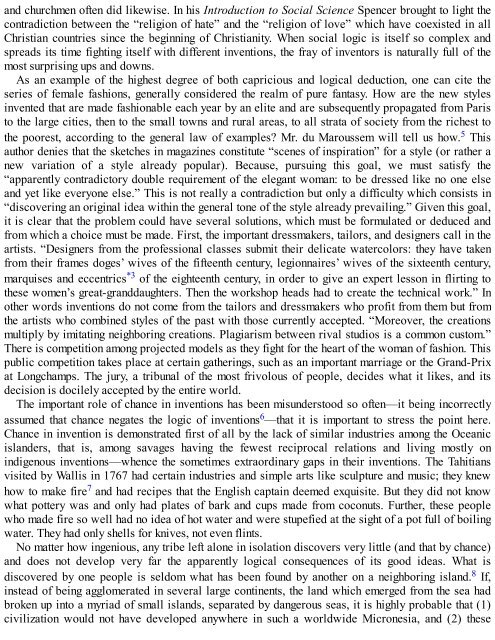3658925934
You also want an ePaper? Increase the reach of your titles
YUMPU automatically turns print PDFs into web optimized ePapers that Google loves.
and churchmen often did likewise. In his Introduction to Social Science Spencer brought to light the<br />
contradiction between the “religion of hate” and the “religion of love” which have coexisted in all<br />
Christian countries since the beginning of Christianity. When social logic is itself so complex and<br />
spreads its time fighting itself with different inventions, the fray of inventors is naturally full of the<br />
most surprising ups and downs.<br />
As an example of the highest degree of both capricious and logical deduction, one can cite the<br />
series of female fashions, generally considered the realm of pure fantasy. How are the new styles<br />
invented that are made fashionable each year by an elite and are subsequently propagated from Paris<br />
to the large cities, then to the small towns and rural areas, to all strata of society from the richest to<br />
the poorest, according to the general law of examples? Mr. du Maroussem will tell us how. 5 This<br />
author denies that the sketches in magazines constitute “scenes of inspiration” for a style (or rather a<br />
new variation of a style already popular). Because, pursuing this goal, we must satisfy the<br />
“apparently contradictory double requirement of the elegant woman: to be dressed like no one else<br />
and yet like everyone else.” This is not really a contradiction but only a difficulty which consists in<br />
“discovering an original idea within the general tone of the style already prevailing.” Given this goal,<br />
it is clear that the problem could have several solutions, which must be formulated or deduced and<br />
from which a choice must be made. First, the important dressmakers, tailors, and designers call in the<br />
artists. “Designers from the professional classes submit their delicate watercolors: they have taken<br />
from their frames doges’ wives of the fifteenth century, legionnaires’ wives of the sixteenth century,<br />
marquises and eccentrics *3 of the eighteenth century, in order to give an expert lesson in flirting to<br />
these women’s great-granddaughters. Then the workshop heads had to create the technical work.” In<br />
other words inventions do not come from the tailors and dressmakers who profit from them but from<br />
the artists who combined styles of the past with those currently accepted. “Moreover, the creations<br />
multiply by imitating neighboring creations. Plagiarism between rival studios is a common custom.”<br />
There is competition among projected models as they fight for the heart of the woman of fashion. This<br />
public competition takes place at certain gatherings, such as an important marriage or the Grand-Prix<br />
at Longchamps. The jury, a tribunal of the most frivolous of people, decides what it likes, and its<br />
decision is docilely accepted by the entire world.<br />
The important role of chance in inventions has been misunderstood so often—it being incorrectly<br />
assumed that chance negates the logic of inventions 6 —that it is important to stress the point here.<br />
Chance in invention is demonstrated first of all by the lack of similar industries among the Oceanic<br />
islanders, that is, among savages having the fewest reciprocal relations and living mostly on<br />
indigenous inventions—whence the sometimes extraordinary gaps in their inventions. The Tahitians<br />
visited by Wallis in 1767 had certain industries and simple arts like sculpture and music; they knew<br />
how to make fire 7 and had recipes that the English captain deemed exquisite. But they did not know<br />
what pottery was and only had plates of bark and cups made from coconuts. Further, these people<br />
who made fire so well had no idea of hot water and were stupefied at the sight of a pot full of boiling<br />
water. They had only shells for knives, not even flints.<br />
No matter how ingenious, any tribe left alone in isolation discovers very little (and that by chance)<br />
and does not develop very far the apparently logical consequences of its good ideas. What is<br />
discovered by one people is seldom what has been found by another on a neighboring island. 8 If,<br />
instead of being agglomerated in several large continents, the land which emerged from the sea had<br />
broken up into a myriad of small islands, separated by dangerous seas, it is highly probable that (1)<br />
civilization would not have developed anywhere in such a worldwide Micronesia, and (2) these









![Genki - An Integrated Course in Elementary Japanese II [Second Edition] (2011), WITH PDF BOOKMARKS!](https://img.yumpu.com/58322134/1/180x260/genki-an-integrated-course-in-elementary-japanese-ii-second-edition-2011-with-pdf-bookmarks.jpg?quality=85)
![Genki - An Integrated Course in Elementary Japanese I [Second Edition] (2011), WITH PDF BOOKMARKS!](https://img.yumpu.com/58322120/1/182x260/genki-an-integrated-course-in-elementary-japanese-i-second-edition-2011-with-pdf-bookmarks.jpg?quality=85)





